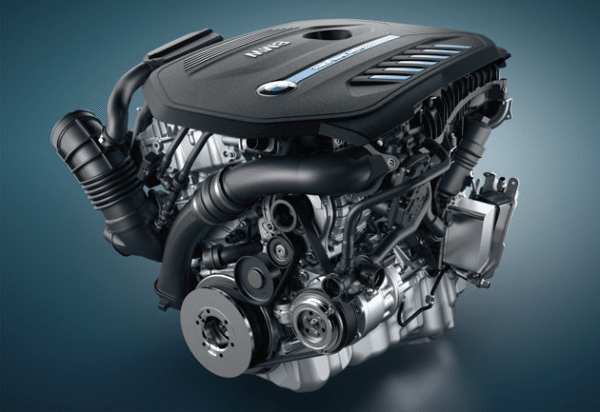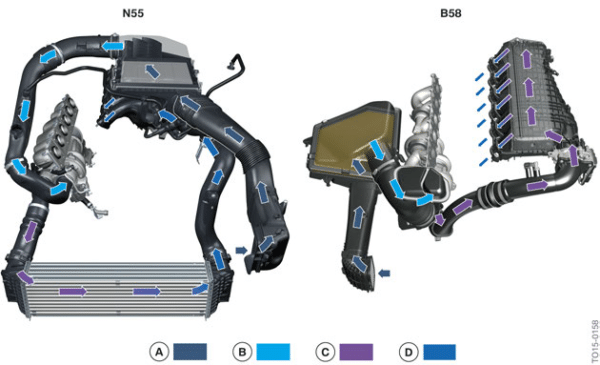Blog
What’s New With the BMW B58 Engine Compared to the N54/N55

BMW’s latest engine release is designated as the B58 engine in the 6-cylinder version. The new B-Series platform is designed to work in 3-, 4- and 6-cylinder variants. The B58 engine will replace the N55 engine throughout their vehicle lineup. Let’s examine what is new with the BMW B58 engine and what the differences are between the N55 and B58 engines. While this list is not all inclusive we will do our best to point out the significant changes.
What has stayed the same
Normally, we look at what has remained the same between new and old engines. On this engine the list is quite small.
- Direct-injected Bosch fuel injector (HDEV5.2) is carried over from the one used on the N55
- Single twin scroll turbo is retained, but is now integrated into the exhaust manifold
- Bulk of the crankcase ventilation system is incorporated into the valve cover
- Other than that these are internal combustion engines with an inline-6 cylinder orientation the design elements of each start to depart pretty significantly
The first principle we need to understand with all new engine designs is to first understand what is driving the changes. The simple answer is tougher fuel economy and emission standards globally. However, we are all a bit spoiled and don’t want to give up any power. We can see these consistent, but often conflicting, goals in engine designs from VW/Audi and their MQB platform, to Jaguar’s Ingenium engines to BMW’s new B-Series engines.
- Reduction and optimization of internal and external engine weight
- Internal engine friction reduction and improved thermal management
- Interchangeability of parts for all displacement and geographic region versions.
- Increased power and torque without sacrificing fuel economy
- Improved comfort in the passenger compartment
What has changed?
- Engine displacement has increased from 2,979 cc to 2,998 cc. This is driven by a bore that is smaller by 2mm (now 82mm) and a stroke that is 5mm longer (now 94.6mm)
- Compression ratio increase to 11.0:1 from 10.2:1
- Crankshaft is forged compared to the cast in the N55
- Drop-forged, cracked connecting rods with IROK coated bearings to cope with the demands of start/stop operation and the wear caused on initial startup due to loss of oil flow
- Elimination of iron cylinder sleeves. The cylinder walls of the B58 engine are coated with electric arc wire spray (LDS). In this procedure a conductive metal wire is heated until it melts. The melt is then sprayed on the cylinder barrels at high pressure. This layer of ferrous material is roughly .3mm thick, extremely wear-resistant and facilitates an efficient transfer of heat from the combustion chambers to the crankcase, and from there to the coolant ducts.
- Engine block now uses a closed deck block design from the open design found on the N54/N55. The closed block design is stronger, but it is heavier, more expensive and restricts coolant flow requiring upgraded coolant system. However, it copes with higher cylinder pressures better especially important since the bones of the block will be shared with diesel platforms.

- Now utilizes an air-to-liquid intercooler integrated into the intake plenum. This is in place of the air-to-air intercooler found on the N54/N55.
- VANOS is responsible for timing adjustment, and Valvetronic is used to control the lift height of the valves and acts as the throttle body. Valvetronic used on the N55 is the 3rd generation and the one that on the B58 is the latest 4th generation. There is no fundamental change in the working principle, the major difference in the B58’s Valvetronic system is it moves the servo motor out of the valve cover (which is N55’s design), and places it outside at the top right-hand side of the cylinder head. Such design brings two major advantages: (1) it significantly reduces the installation space; (2) It brings down the engine’s total height and lowers the engine’s center of gravity.
- Introduction of a heat management module to cope with the higher temperatures seen in this engine. The heat management module on the B58 is mechanically powered directly by the crankshaft through a serpentine belt. Inside the module, the coolant flow rate is adjusted by a rotary valve. The mechanical coolant pump avoided the hassle of possible failure of the electric type in previous BMW engines. However, to deal with the situation that the turbo still needs to be cooled after the engine is turned off, an extra dedicated electric pump is added to the turbo unit to tackle this issue.
- BMW put a focus on engine weight distribution. On the N54/55 engine, they placed the alternator, AC compressor, timing chain, and engine oil filter assembly towards the front portion of the engine, therefore the engine’s center of gravity center is front-biased. However; the B58 treats this differently: it places the oil filter and its radiator, VANOS timing chain to the back of the engine. This is good for the weight distribution, however with the price of maintenance difficulty and cost. Although the oil filter cap is hiding a little bit deep in the engine bay, it is still not too hard to reach. However, the VANOS system is a huge pain for maintenance since it is located right behind the engine and extremely close to the firewall. It is impossible to service the VANOS system without taking the whole engine out of the engine bay. So, for those 340i owners who are out of warranty, please pray that the VANOS system does not break.
- Since there will be noises when the timing chain is operating, BMW placed a sound insulation foam between the cylinder head/valvetrain cover and the passenger cabin firewall.
Regardless of what BMW engine you have under the hood, remember at Alex’s Autohaus we are always here to help you with BMW repairs, maintenance, and performance upgrades. Give us a call at (801) 566-6115 to discuss what we can do for you, or schedule online today.

Nationwide Warranty
3 YEAR, 36,000 MILE
Alex’s Autohaus offers all customers the Bosch and Tech-Net Peace of Mind Nationwide Warranty. The 36 month/36,000 mile warranty is honored at over 10,000 service centers across the country. Our 36,000 mile warranty is the best in the business!
Read More Schedule Now